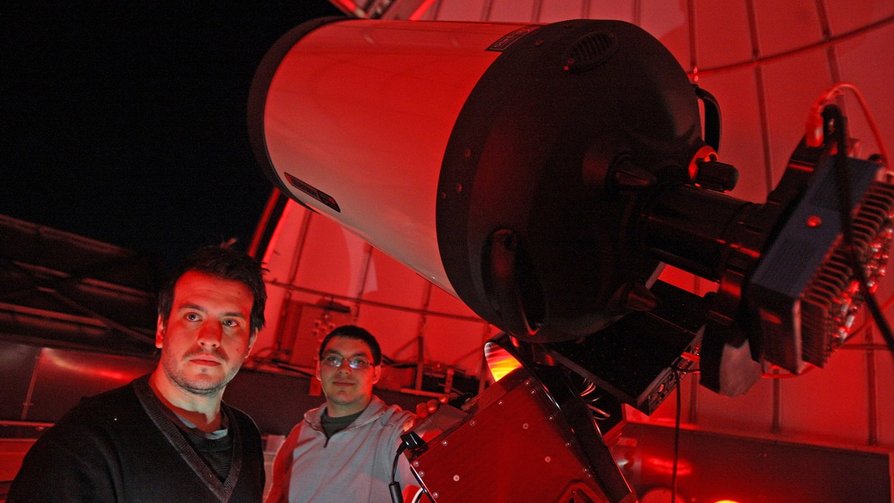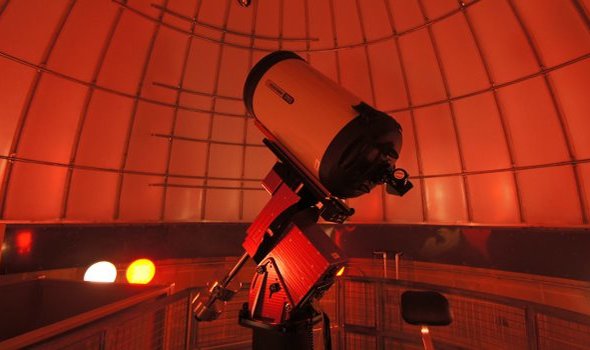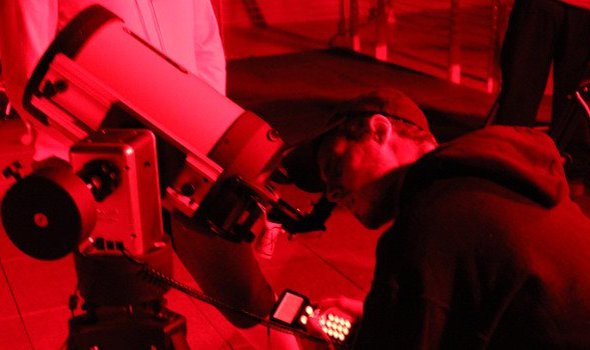The BSU Observatory is home to the BSU Experimental Astrophysics Research (BEAR) Team, and supports additional undergraduate research related to astronomy courses.
The BEAR Team, funded by the NASA MASGC (Massachusetts Space Grant Consortium), is a group of students dedicated to observational astronomy research. They collect data using the equipment in our main dome, follow an observing schedule, participate in data analysis and develop research projects. Their research so far includes photometry of exoplanets, exoplanet candidates, asteroids and variable stars, studying the width-luminosity relation for type Ia supernovae, and most recently searching for kuiper belt objects. Several students also dabble in astrophotography. Some physics courses also require students to do research independently of the team. Some examples of recent student research posters are listed below.
Student Research
Accordion Content
Patrick Rogers
We analyze the B filter light curves of ASAS-SN 16lg, ASAS-SN 18bt, and AT2021 gtp to measure the distance to the event using the distance modulus. For type Ia supernovae there is a widely understood relationship between the decline rate of the B filter and the distance to the supernova. By incorporating the V filter, we work to create a dust extinction calculation to more accurately account for absorption due to stellar and interstellar dust clouds between the object and our location. Many methods to account for dust extinction exist so we study the benefits and precisions of these models.
Please follow this link to see Patrick's poster on this topic.
Alex Whitman
Quasars are some of the most amazing objects in the cosmos and yet there is still so much we do not know about them. Markarian 421, is the brightest of these unique objects in our night sky. The main goal of this research is to better understand quasars and how they operate. We observed Markarian 421 using the red, green, infrared, and hydrogen-alpha filters from March 12th, 2021, to July 15th, 2021, in the BSU Observatory dome and constructed light curves for further analysis of the active galactic nucleus (AGN). This project is a first of its kind here at BSU and will pave the way for future students to measure objects of this nature. Understanding AGN such as quasars is vital to comprehending the evolution of galaxies. Please follow this link to see Alex's poster on this topic.
Caleb Derochea
To measure the magnitudes of celestial objects, reference stars with stable magnitudes are used to account for fluctuations in Earth's atmosphere. If no such well-studied reference stars are within the field, other stars must be used so long as they are not variable. We created a Microsoft Excel spreadsheet which harbored a linear regression algorithm to detect star variability and then transferred it to Python to make the process of finding variable stars faster. Via Python packages such as sklearn, numpy, scipy, etc., we were able to produce a quicker and simpler way to analyze the star variability from their raw CSV file data and their accepted magnitudes from an online database. The code was successfully tested on variable stars TZ Aurigae and BX Pegasi. Please follow this link to see Caleb's poster on this topic.
The BSU Experimental Astrophysics Research (BEAR) Team
In September 2015, Bridgewater State University was awarded a MA NASA Space Grant to run a 1-year pilot observing program: the BSU Experimental Astrophysics Research (BEAR) Team. Since that time, the eight official student participants have observed multiple exoplanets, asteroid 2343 Siding Spring, and Supernova ASASSN - 16 ad among other targets, such as mystery star KIC 8462852 and various galaxies and nebulae. To see the poster produced on this topic, please follow this link.
John L'Heureux
As part of an ongoing effort to improve the quality of our photometry, John applied various levels of ensemble photometry to exoplanet data taken at the BSU Observatory and designed protocols for its future use at our institution. In the course of his initial experiment, he noticed an unexplained variation in brightness in a AAVSO reference star which he then investigated. Click here to read John's initial poster on ensemble photometry. Click here to read his poster regarding reference star 000-BCF-128.
Maria Patrone
As part of an ongoing effort to conduct exoplanet research using the BSU Observatory, we prepared and submitted data on exoplanet Qatar 1b to the Exoplanet Transit Database (ETD), collected, processed and analyzed supplementary data on Kepler Object of Interest (KOI) K03810.01, and studied methods of fitting exoplanet light curves. Please follow this link for more information.
Jessica Bamford
KIC 8462852 was observed by the Kepler Space Telescope from 2009-2013 and brought to the attention of scientists for its unique light curve with magnitude decreases up to ~20%. Thus far, no solid evidence exists to explain the light curve. We conducted a literary review of observations for this star, and made new observations at BSU. For 13 nights from 05/31/2016 - 12/042016, this star was imaged at the BSU Observatory in B, V, R and luminance filters. During Spring 2017, we processed these images in MaxIm DL 6 to produce light curves for each filter. Please follow this link to see Jessica's poster on this topic.
Research in astronomy at BSU is not limited to imaging with our equipment. Other research projects have included statistical studies to determine how many stars in our galaxy have planets, determining stellar variability using the Planet Hunters database, identifying and studying areas of solar active regions, correlating solar flares with power outages on Earth, and more.
We have recently acquired a Baader Baches Echelle-Spectrograph, which we look forward to using for spectroscopy of variable stars and more!


